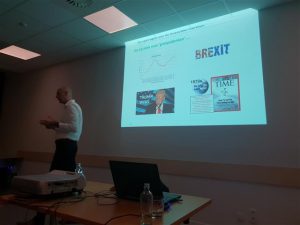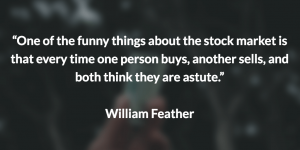Past weeks my schedule has been pretty hectic. My mom was rushed in emergency to the hospital. Thank God she is now back in recovery. As a result, writing a blog post was low in my priorities. Besides the illness of my mom, my schedule was spiced with business trips and family activities. One evening was slotted in for being present at the presentation of Jan Longeval.
Jan Longeval was invited by the investors Club InvestMasters, Their website can be found here.
Read below our summary.
Who is Jan Longeval ?
Mr.Longeval, member of the Group Executive Committee, director of Bank Degroof Petercam and Co-CEO of Institutional Asset Management resigned. Degroof Petercam is a reference financial institution with a history dating back to 1871. As an independent group owned by family shareholders with a long term commitment,they serve private and institutional investors.
Their clients benefit from a unique combination of services in private banking, institutional asset management , investment banking (corporate finance and financial intermediation) and asset services. The total clients assets (under management, under administration and in custody), double counting excluded, amount to more than 63 billion euro.
Jan Longeval was 10 years part of the group executive committee and build his career from analyst towards directors private banking. He also educated more than 10 years at the high school Ehsal. With more than 25 years experience, Mr. Longeval has a sharp eye to analyse the finances of Belgium and the international markets.
Recently he has released a 300 pages book “God dobbelt niet op de beurs” where he explains what mistakes retail and professional investors make and how they avoid them. I purchased the book to improve my financial knowledge.

Summary of the Presentation “The Stock Market, your Friend or your biggest Enemy ?”
Jan starts his presentation with the painting on the cover of his book. “If you understand the story behind the painting, you will understand the story behind my book”, Jan says. The retail investor had very bad annualized returns over the past years. Investors have been burning wealth over time. This has been the same for professional investors. If we look at the Belgian government his financial state, we can conclude that the pension and healthcare costs will explode tremendously in the coming years. Paying a pension paid by the government will be mathematically impossible after 20-30 years. Belgium does not have any pension reserves… so you are warned !
if you want to sustain your living standards, you will have to learn how to invest. The interest rats in the future will decrease even lower, possible to -4 or -5%. Today central banks own 30% of all government debt. Don’t think you are SAFE with a savings account. You will have to pay in the future for keeping cash in a savings account. A negative interest rate is a TAX on your savings account money.
If you want to invest, there’s an easy way to do this by applying passive investing in ETFs or trackers. The retail investor today hardly builds wealth as his average performance is just above inflation. Investing in funds managed by professional investors is not even better. An example is Carmignac Patrimoine. Investing in this fund was a complete disaster.

An investment strategy needs to be solid with a foundation which can protect your house for the long term. You can simply invest today with low costs in a diversified MSCI World index. Investing in one currency is not going to lower your currency exchange risks when you invest in a company. Some companies do only sales abroad and have as a result currency exposure risks. Investing smart is FIRST AVOIDING UNNECESSARY RISKS. First topic is managing risk with stock picking. There are no safe Buy & Hold stocks. Examples in Belgium were the financial banks such as Dexia and Fortis BNP. All sectors can be disrupted in the future. So if you think you can avoid risk by buying specific sectors, you think wrong.
The US stock markets have been a value creation machine of 35.000 billion $ in the past 90 years. However this was created by only 4% of all stocks. So always diversify your portfolio.

Can we predict the stock markets ? Can we predict a hard or soft brexit ? Can we protect our portfolio ? Jan explains patterns from Louis Bachelier, predecessor from Einstein. So the stock markets act like an organic mechanism that can not be predicted within a pattern. Even the mathematics world tries to visualize the evolution of different phenomenons. The bottom line is that the stock market is a random process. Then Jan explains the butterfly effect and its relation to the stock markets.
Investing in the stock market is dangerous but if you were not invested, you simply lost money. If you missed the best 20 days in the stock market, you lost also 4% return. In private banking, asset managers always try to predict. An example is Mr. Roubini or Mr Doom who made 16 predictions. None came true. Don’t predict the markets. You simply need to follow certain rules when investing in the stock markets. You can invest for dividend return and price capitalization. The return was 9% and your dividend return was 4%. So first of all you need to invest passive in world ETFs or ETFs that pay you dividend.
So which rules you need to apply for active investing ? Jan explains the 4 conditions for the wisdom of the masses. These 4 conditions will result in a fair value of a stock or bond.
Rule 1. Identify Group Thinking where there’s difference in opinion. Extreme positivism or negativism with extreme values. An example was the housing market. If you have seen the movie “The Big Short”, you understand. If everybody thought Trump wouldn’t win, then you have an example of groups thinking which you can use as an opportunity. UK economy has been growing with Foreign Direct Investment. ETFs from the UK economy are a big opportunity. GBP has dropped 17% which is also a benefit. You can always find examples of group thinking. Another example is green bunds which look more and more like a bubble.
Successful investing is a combination of passive and active investing. The hardcore is passive investing and the satellites are investment opportunities related to groups thinking. Don’t let them scare you, just apply this rule and your portfolio will sustain any stock market shocks.
The evening ends with a Questions and Answers from different investors. One question was about the cryptocurrencies. Investing is always a choice. If I can invest in physical gold, why would I invest in a virtual currency ? Central banks are doing monetary experiments today. In the past the dollar was connected to gold. Since this connection has given up, we see a currency devaluation. A cryptocurrency has one big disadvantage that it can be hacked. If negative interest rates will continue, gold will remain its value. Jan has now invested for first time in gold. So why would he invest in cryptocurrencies if he has the alternative of gold?
Final Note
What did we learn ? The most important part of this presentation was the strategy applied . Passive investing accounts for 20% today in the US markets. If we imagine that everyone is passive invested, then there’s no more price action. So active investing will start again. Jan believes that this 20% will evolve to 50% in the future. Active and passive investing will always come together. At the end of the presentation, Jan shared how he changed the physical real estate portfolio of his mom in a diversified portfolio of passive investing with MSCI world index combined with two REITs Home Invest and Aedifica. This takes the burden away from tenants and other maintenance costs and gives his mom who was also present in the public, peace of mind.
It was interesting for us to attend this presentation. We hope you learned something from this blogpost and you appreciate our effort to write up the summary.
Don’t hesitate to leave your comments and feedback. Let us know what you think.
Good luck with your personal finance strategy! Thanks for following us on Twitter and Facebook and reading this blog post. As always we end with a quote.



No Comment
You can post first response comment.